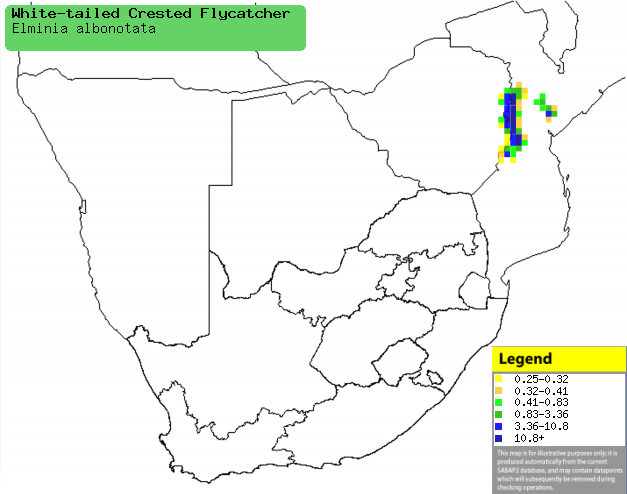|
Elminia albonotata
(White-tailed crested flycatcher, White-tailed flycatcher)
[= Trochocercus albonotatus]
Witstertvlieëvanger [Afrikaans]; Bergkuifmonarch
[Dutch]; Tchitrec à queue frangée [French];
Weißschwanz-schopfschnäpper [German]; Papa-moscas-de-cauda-branca
[Portuguese]
Life
> Eukaryotes >
Opisthokonta
> Metazoa (animals) >
Bilateria >
Deuterostomia > Chordata >
Craniata > Vertebrata (vertebrates) > Gnathostomata (jawed
vertebrates) > Teleostomi (teleost fish) > Osteichthyes (bony fish) > Class:
Sarcopterygii (lobe-finned
fish) > Stegocephalia (terrestrial
vertebrates) > Tetrapoda
(four-legged vertebrates) > Reptiliomorpha > Amniota >
Reptilia (reptiles) >
Romeriida > Diapsida > Archosauromorpha > Archosauria >
Dinosauria
(dinosaurs) > Saurischia > Theropoda (bipedal predatory dinosaurs) >
Coelurosauria > Maniraptora > Aves
(birds) > Order: Passeriformes
> Family: Sylviidae
Distribution and habitat
Occurs in scattered populations across eastern DRC and
western Kenya, south to Malawi, Tanzania and southern Africa. Here it is common
in Zimabwe’s eastern highlands, living in montane and evergreen forest, but
avoiding very dense vegetation.
|
 |
|
Distribution of White-tailed crested flycatcher in southern Africa,
based on statistical smoothing of the records from first SA Bird Atlas
Project (©
Animal Demography unit, University of
Cape Town; smoothing by Birgit Erni and Francesca Little). Colours range
from dark blue (most common) through to yellow (least common). |
Food
It mainly eats insects, gleaning them from leaves and
branches or hawking the aerially. It may also join mixed species foraging
flocks, along with Stripe-cheeked bulbuls and Swynnerton’s robins.
Breeding
- The nest is a cup pointed at the base, built of woven green moss secured
with spider web, made by the female in about 11 days. It is typically placed
in the fork of a sapling’s branch, or alternatively in bushes or weeds,
usually 1-2 metres above ground.
- Egg-laying season is from October-January.
- It lays 2-3 eggs, which are incubated by the female for about 17 days,
while the male feeds her at the nest.
- The chicks are fed by both parents with flies and small grubs caught in
the vicinity of the nest. After about 12 days the adults stop feeding them,
which encourages the brood to take their first flight. The juveniles become
fully independent at the end of the breeding season.
Threats
Not threatened.
References
-
Hockey PAR, Dean WRJ and Ryan PG 2005. Roberts
- Birds of southern Africa, VIIth ed. The Trustees of the John Voelcker
Bird Book Fund, Cape Town.
|
